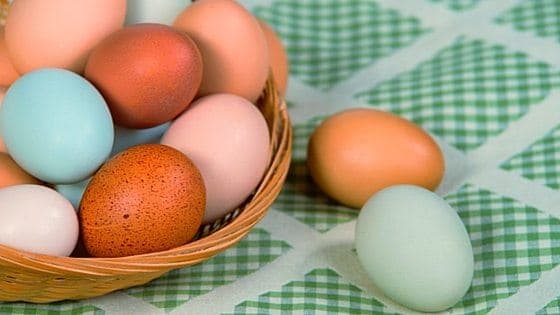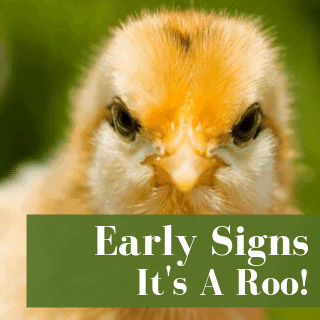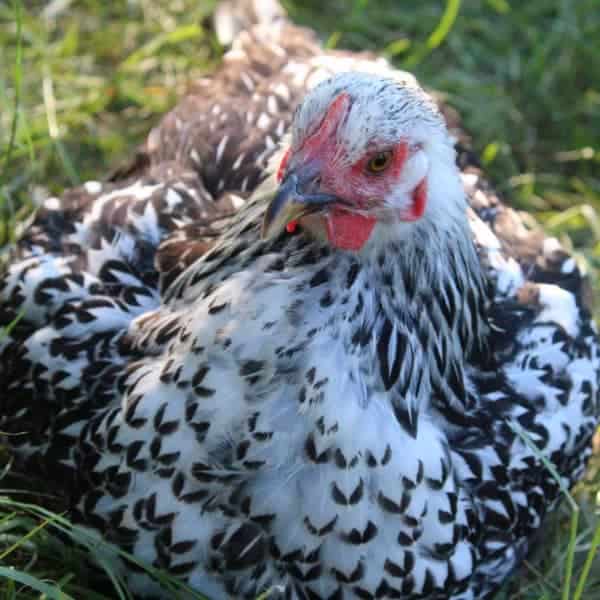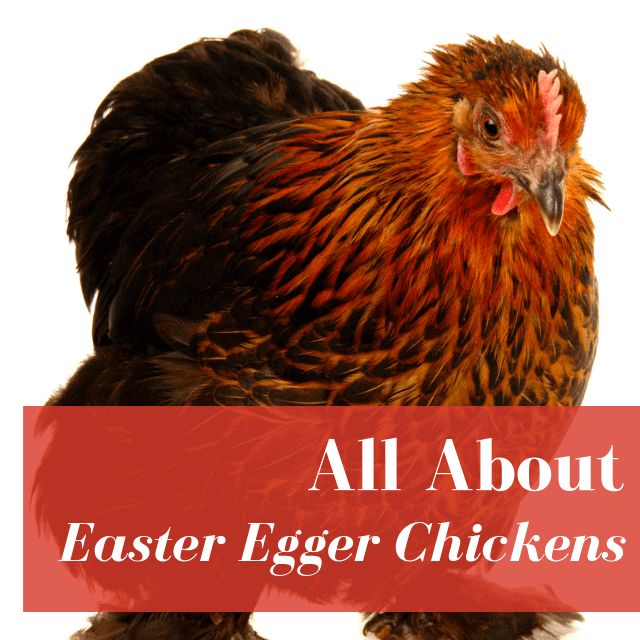Have you ever seen a photo of a very pretty chicken and decided you MUST have one? That’s how I learned about Blue Laced Red Wyandottes!
In this article, you’ll discover why these hens and roosters are so beautiful, how to breed them, what color eggs they lay, and more! This is truly a special breed that I wouldn’t want you to miss out on.
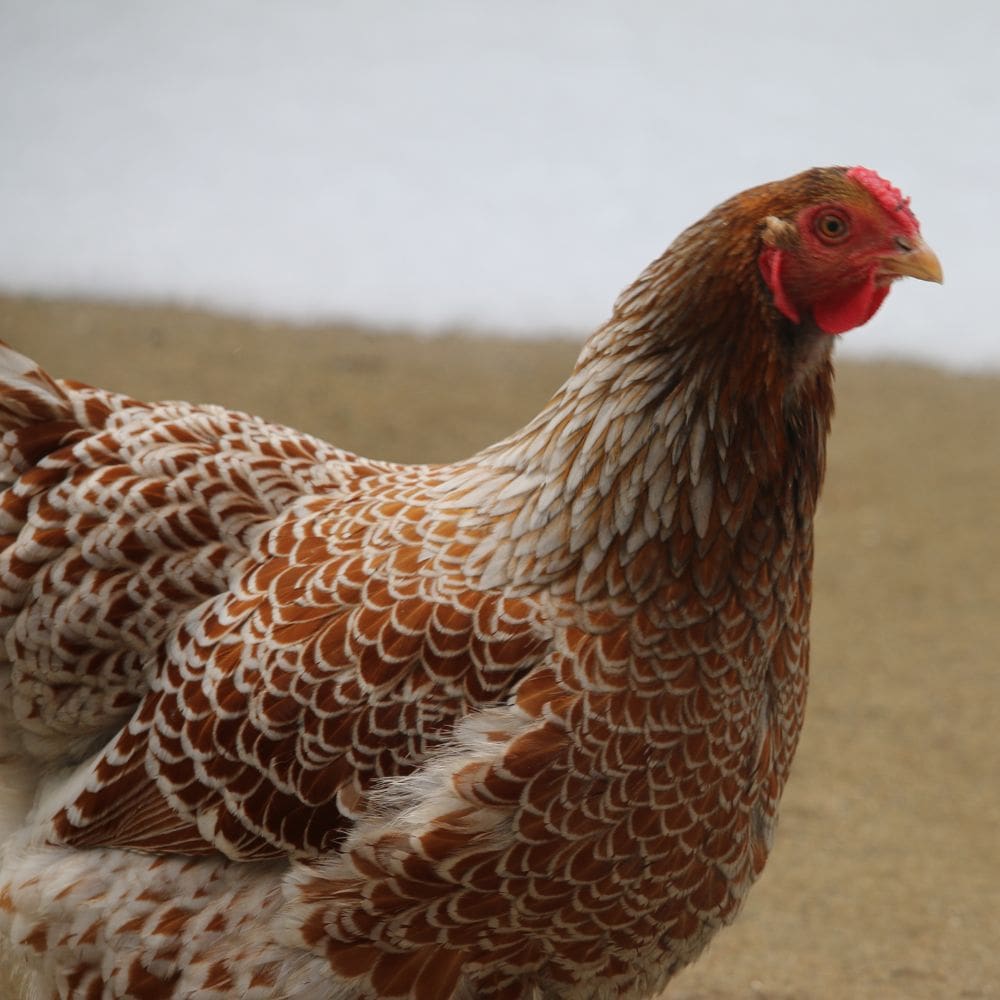
Table of Contents (Quickly Jump To Information)
The Origin of Blue Laced Red Wyandotte Chickens
These fluffy-feathered birds got their start clear across the USA, in a little state known as New York. In the early 1870s, a group of 4 gentlemen – H.M. Doubleday and John Ray of New York State, L. Whittaker of Michigan, and Fred Houdlette of Boston, Massachusetts – mixed Brahma, Hamburg, and Cochin chickens.
Their goal was to develop a dual-purpose chicken with some striking plumage, and they certainly came up with a winner. The resultant bird was named after the Wyandotte Nation. The name was an honorific, as the bred creators had no direct historical relation to Wyandotte Nation. The first Wyandotte color was Silver Laced.
Although the Blue Laced color was developed in the USA, the breed wasn’t perfected there. A group of chickens sailed across the pond to England. From there, they continued on to Germany. Once in central Europe, the Blue Laced coloring was perfected, and a group of hens and roosters soon found their way back to the USA.
By the 1920s, these beautiful chickens had become became quite popular. But because they don’t breed true, the Blue Laced Red Wyandotte still hasn’t officially become recognized in USA.
Temperament of Blue Laced Red Wyandottes
Blue Laced Red Wyandotte chickens are docile, curious, and kid-friendly. They are well-mannered and adore the attention of their people. Some have earned a reputation for their sass, but these are always individual cases and are not indicative of the entire breed. Sometimes a sassy chicken is fun!
Blue Laced Red Wyandotte chickens deal well enough in confinement, but love roaming and are excellent foragers. If you can give them the space, I’m sure they would love it.
What Colors Do Blue Laced Red Wyandotte Chickens Come In?
There are three varieties:
- Blue (which is quite similar to the blue of pigeons)
- Black
- Splash laced red (which is a kind of brick red coloring, caramel, bay, or deep mahogany)
What is truly remarkable about these birds is the lacing on many of their feathers. These have a core color with a blue edge, and they are beautiful! There are some other common Wyandotte colors:
- Silver Laced
- Gold Laced
- White
- Black
- Buff
- Partridge
- Silver Penciled
- Columbian
- Blue
We are not referring to APA standards in the USA, but rather variations of colors that might result from breeding these birds.
Beautiful Feathers
These birds have one of the floofiest hind ends that you’re likely to find in a chicken coop. The feathering down there is so poofy that you might notice your chickens need some extra cleaning to get rid of poopies, or some trimming to help facilitate mating. Also, you can use my favorite fluffy feather treat to make these girls extra pretty.
Beyond this, they should have an erect tail that completes the U-shaped profile (head and tail). Roosters in profile should be somewhat heart-shaped, and all should have nice full breasts. Female tails should start directly behind their hackles, and the fluff should go for days from there. Their backs should be medium in length and curve upwards as it gets to the tail.
They have yellow shanks. Their comb is a close-fitting rose that is safe against colder weather. Their brush, wattles, face, and earlobes are red, and they have deep-set eyes.
Even though this breed was originally intended for dual-purpose functions (eggs and meat), there are bantam varieties. These varieties are not ideally suited for the meat purpose. But they are great layers, just like the standard-sized. You can learn more about bantams here.
So, there’s a lot of fluff. But how big do Blue Laced Red Wyandotte chickens get?
Roosters grow to be about 8.5 pounds. Hens grow to about 6.5 pounds. They are good-sized chickens that actually appear a little larger than they really are. Their abundance of feathers can be quite deceptive.
Are Blue Laced Red Wyandotte Chickens Cold Hardy?
These birds certainly are pretty good in the cold. Some might even say that they are excellent in the cold, thanks to their dense plumage and little comb. Smaller combs aren’t particularly susceptible to frostbite. And their fluffy feathers protect them from cooler temperatures.
Well-built coops will help keep them comfortable even in the harshest weather conditions.
Do Blue Laced Red Wyandottes Breed True?
No, unfortunately. This might be the biggest problem people encounter with this breed. Depending on the rooster/hen combination, offspring can make blue, black, or splash results.
The resultant chick color combinations are actually pretty exciting because you never know what you’re going to get. But it also leads to a lot of unpredictability. You’ll notice the look of each individual bird is different from breeder to breeder.
Blue Laced Red Wyandotte chickens have a recessive gene in their lavender-blue coloration. They also have an incomplete dominant gene in the Andalusian blue coloration.
Luckily, there are a number of resources available to help figure out possible color offshoots of these mixes. Most breeders will say that when breeding blue to blue, you end up with a mix of 50% blue, 25% black, and 25% splash.
Another site posted the results of 100 chicks below:
- Blue X Blue = 50% Blue, 25% Black, 25% Splash
- Blue X Splash = 50% Blue, 50% Splash
- Blue X Black = 50% Blue, 50% Splash X Black = 100% Blue
- Black X Black = 100% Black
- Splash X Splash = 100% Splash
While this isn’t an enormous sample size, it’s still enough information to show that these chickens won’t always look like you expect! However, your coop will certainly be very colorful!
If you’re thinking of breeding, you’ll need to consider whether Blue Laced Red Wyandotte chickens go broody. As a breed, the hens are not particularly broody. So they’re less likely to want to hatch eggs. However, each hen is an individual.
If you house your Wyandotte hens with some VERY broody cluckers (like Silkies), then they’re more likely to catch the mothering bug.
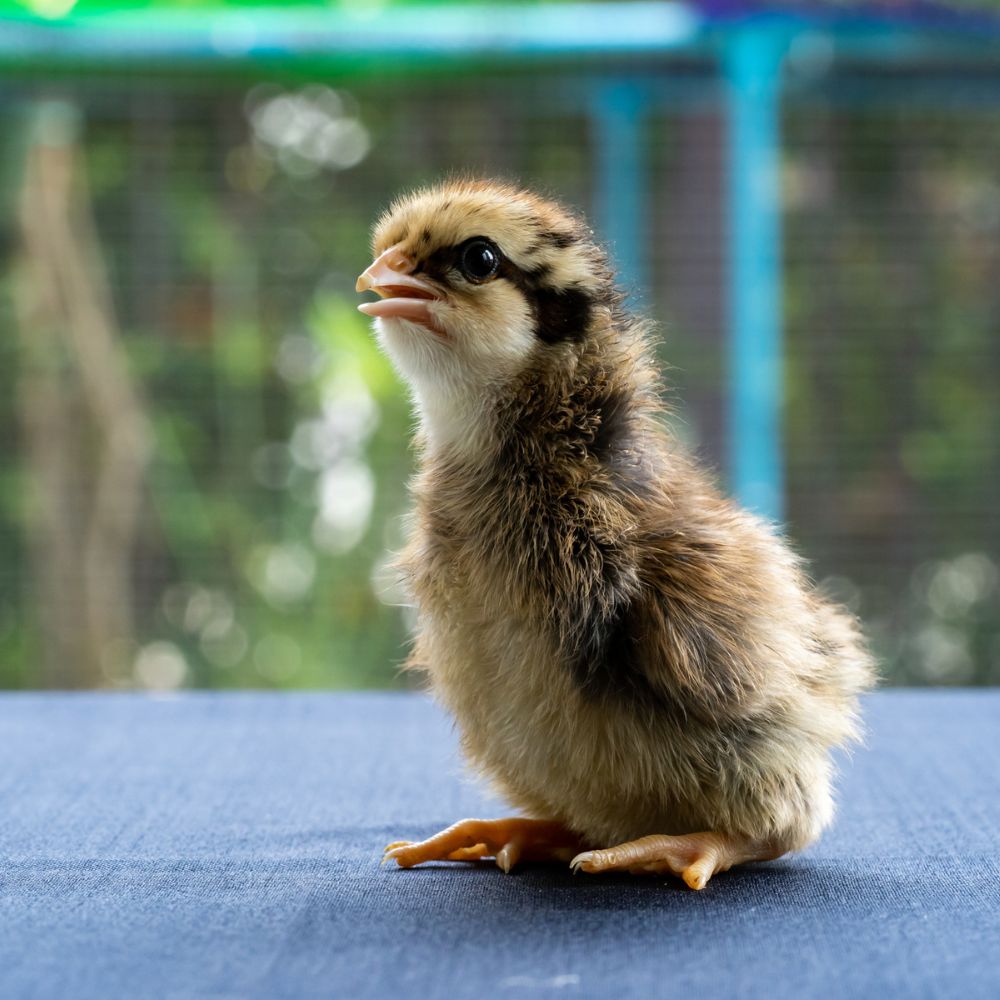
Blue Laced Red Wyandotte Chicks
Blue Laced Red Wyandotte chicks are mottled dark brown, black, and blue, with tan markings. These are adorable chicks with lovely coloring, which can help discerning owners identify the coloring as they get older.
Dark chicks usually grow out to be dark blue, lighter ones are mid-color, and palest have nearly white lacing. From hatching, chicks take about 18 months to fully color out, and they are not easy to gender at birth.
Are Blue Laced Red Wyandotte Chickens Good Layers?
The average hen will lay about 200 large eggs each year. This is not a chart-topping number, but it is a very healthy amount of eggs.
Their eggs are light pink or peach. Compared to some single-purpose chickens, Blue Laced Red Wyandotte hens start laying a little late. Their humans can expect the first eggs to appear at about 8 months of age.
Do They Have Known Health Issues?
Rosecomb chickens are known among chicken owners for having a gene directly linked to the comb – a common occurrence of a low fertility rate. Because they are rosecomb chickens, Blue Laced Red Wyandotte chickens might suffer from this decreased fertility rate. However, this won’t apply to every bird, and it’s just something to keep in mind.
You should also be aware that because they’re so large, some hens have a hard time getting away from predators. So, be extra cautious to provide a predator safe coop and run.
Summary
Overall, these birds are a true pleasure. Because of the tricky means of breeding them, though, they might be a little more expensive than other chickens.
Adding a Blue Laced Red Wyandotte to your yard will certainly be a visual treat for visitors! Or if you’re just looking for a unique splash of color for your own pleasure. You’ll also get a good supply of eggs and a loving temperament!
5 Best Hatcheries to Buy Blue Laced Red Wyandottes
1. Meyer Hatchery
Find more information and prices here: Meyer Hatchery
Meyer Hatchery is based in Polk, Ohio, and boasts itself as the “premier Poultry Source.” Priding itself on customer service and availability, Meyer Hatchery provides a variety of chicken breeds to meet customer demands for color and diversity. They welcome the mixing and matching of breeds of the same poultry type to meet minimum order requirements for safe shipping. Not sure what kind of breed is right for you? Be sure to check out this comprehensive list.
To help with orders, they have a calendar of hatchings.
Meyer has a variety of means of communication, including multiple phone numbers, fax, and email. They also run a blog that covers everything from breeds to plant pairing with chickens, feed, cooking recipes, fowl entertainment, and survival tips.
Looking for some other good resources when it comes to entertaining and treating your flock? Be sure to grab some of these mealworms for your birds. They’re entertaining and a great source of nutrition!
Advantages
- Website is up-to-date in real time.
- Accepts checks and credit cards.
- Guarantees gender of chicks either through refund or store credit.
- Optional vaccination.
- Member of the National Poultry Improvement Plan (NPIP), and provide NPIP VS Form 9-3 free of charge.
- Offer orders of over 100 chicks.
Disadvantages
- Limited store hours that change with the season.
2. Cackle Hatchery
Find more information and prices here: Cackle Hatchery
Cackle Hatchery proudly boasts that they have been hatching and shipping since 1936. A third-generation hatchery based in Missouri, their mission is to provide customers with quality poultry for showing, meat, enjoyment, and egg production. They ship throughout the USA, including Alaska, Puerto Rico, and Hawaii. They offer nearly 200 different types of chickens at all stages.
Cackle also offers many other kinds of poultry including ducks, waterfowl, game birds, turkeys, and other fowl. They are also a good source of supplies and books.
Advantages
- Discounts if you buy male chicks.
- Vaccinations available.
- Only need 3 birds to ship (or just one for male birds).
Disadvantages
- Limited availability (February through August).
- Sold as baby chicks only.
3. Murray McMurray Hatchery
Find more information and prices here: Murray McMurray Hatchery
Murray McMurray started his chicken business in 1917. As a banker, he sold his chicks to locals through the bank, and by 1919, he had developed his own stock of chickens. During the Great Depression, he devoted himself to chickens full-time. Since then, Murray McMurray Hatchery has developed into one of the largest chick hatcheries in the country. They sell more than just chickens, with ducks, geese, guineas, turkeys, other fowl, and game birds all in the catalog.
Sexed male chicks tend to be the cheapest, meaning you can get some serious savings if you’re planning on raising these birds primarily for meat. You can also buy pullets or mix and match your order with chicks of other breeds, too.
Advantages
- Bulk discounts available.
- Excellent breed availability through August.
Disadvantages
- Minimum order of six birds at a time.
- Available only as chicks.
4. Hoover’s Hatchery
Find more information and prices here: Hoover’s Hatchery
Another established brand, if you’re looking for chicks, is Hoover’s Hatchery. Hoover’s supplies many farm and garden supply stores in the United States with their chicks, making them a smart choice if you want to skip the middleman and order from the hatchery directly.
Plus, Hoover’s offers free shipping on practically everything you order. You’ll have to buy at least 15 chicks; so Hoover’s might not be the best option if you live in a city with chicken restrictions. However, as long as you’re willing to buy in bulk, it’s a smart choice. You can even mix and match your order by adding other birds of other chicken breeds along with poultry species like pheasants, turkeys, guineas, ducks, and more.
Another benefit of ordering from Hoover’s Hatchery? Despite the fact that this hatchery is located in Iowa, not necessarily a warm-weather state, it hatches chicks all throughout the year – a must-know feature if you plan on buying chicks around Christmastime.
Advantages
- Excellent guarantee and refund policy in case of shipping problems.
- Hatches chicks during the winter, one of the few hatcheries to do so.
- Sells other kinds of poultry too.
Disadvantages
- Large minimum order.
- Offers chicks only.
5. Welp Hatchery
Find more information and prices here: Welp Hatchery
Located in Bancroft, IA, Welp Hatchery was founded way back in 1929 by Joseph H. Welp. Without a doubt, it’s one of the best hatcheries to buy Blue Laced Red Wyandottes.
While their specialty is Cornish Rock Broilers, they have diversified to include a wide range of chicken breeds. To simplify their orders, they have a catalog available for viewing or downloading. From its shipping points in Iowa, New Mexico, Minnesota, and Wisconsin, this hatchery truly has a wide reach.
Advantages
- Can choose the breeding date on the product page.
- Marek’s immunization is a one-click process.
Disadvantages
- Maximum orders of 25.
Maat van Uitert is a backyard chicken and sustainable living expert. She is also the author of Chickens: Naturally Raising A Sustainable Flock, which was a best seller in it’s Amazon category. Maat has been featured on NBC, CBS, AOL Finance, Community Chickens, the Huffington Post, Chickens magazine, Backyard Poultry, and Countryside Magazine. She lives on her farm in Southeast Missouri with her husband, two children, and about a million chickens and ducks. You can follow Maat on Facebook here and Instagram here.

